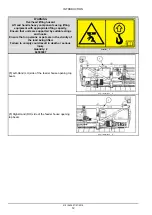
INTRODUCTION
Personal safety
Your machine may be equipped with special guarding or other devices in compliance with local legislation. Some of
these require active use by the operator.
Therefore, check local legislation on the usage of this machine.
Hydraulic system safety
• Hydraulic oil leaking under pressure can penetrate the skin and cause infection or other injury. To prevent
personal injury:
• Relieve all pressure before disconnecting fluid lines.
• Before applying pressure, make sure all connections are tight and components are in good condition.
• Never use your hand to check for suspected leaks under pressure. Use a piece of cardboard or wood for this
purpose.
• If injured by leaking fluid, seek medical attention immediately.
• The hydraulic hoses and fittings on your machine meet engineering specifications for the particular function. When
replacing damaged, blown or worn hoses or fittings, use only manufacture authorized service parts.
• Care in hydraulic hose installation is a must:
• Make sure pressure is relieved before starting installation procedure.
• DO NOT kink or twist a hose, failure may occur.
• Properly route the hose.
• Have a certified hydraulic technician install the hose.
• Remove air from the hydraulic system after installing any hydraulic component.
• Periodically check hydraulic system for leaks or damage. check for:
• Leaks at hose fitting or in hose.
• Damaged hoses and/or fittings.
• Kinked, crushed, flattened, hard blistered, heat cracked, charred, twisted, soft or loose covered hoses.
• Corroded or damaged fittings.
• Leaking ports.
• Excessive dirt and debris around hoses and/or fittings.
• Damaged or missing hose retaining clamps, guards, shields, etc.
• DO NOT stand on or use a hose as a step. DO NOT pull or apply external forces to the hose. The hose may fail
and cause injury.
• Keep all persons away from the working area. Mechanisms controlled by fluid power can become hazardous if a
hose fails. Lifted mechanisms can fall to the ground, machine steering may fail, etc.
• Stay clear of a pressurized hose assembly that has blown apart. Hose fittings can be thrown off at high speed and
a loose hose can whip around with great force.
• Hydraulic fluid can reach high temperatures. Allow fluid to cool before servicing the system.
• Escaping fluid under pressure may form a mist or fine spray which can flash or explode upon contact with an ignition
source.
• Vibration can reduce hose service life. Make sure all retaining clamps and/or devices are secured.
• Environmental conditions can cause hose and fittings to deteriorate. Inspect hydraulic hoses periodically. Replace
worn or damaged hoses and fittings.
Safety requirements for fluid power systems and components - hydraulics (EUROPEAN
STANDARD PR EN 982)
• Flexible hose assemblies must not be constructed from hoses which have been previously used as part of a hose
assembly.
51510606 27/07/2018
4
Find manuals at https://best-manuals.com
Содержание CornMaster 9208-22
Страница 4: ... 71 480 Oiler system 71 1 51510606 27 07 2018 Find manuals at https best manuals com ...
Страница 5: ...51510606 27 07 2018 Find manuals at https best manuals com ...
Страница 6: ...INTRODUCTION 51510606 27 07 2018 1 Find manuals at https best manuals com ...
Страница 41: ...This as a preview PDF file from best manuals com Download full PDF manual at best manuals com ...










































